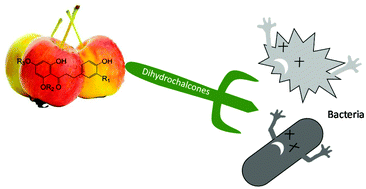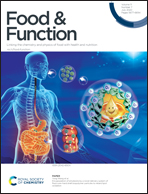Dihydrochalcones in Malus inhibit bacterial growth by reducing cell membrane integrity†
Abstract
In recent years, increasing research has evaluated the use of natural products as antimicrobial food additives. In this study, antibacterial activity was evaluated for six dihydrochalcone compounds from Malus. Phloretin and 3-hydroxyphloretin exhibited antibacterial effects on both Gram-positive and Gram-negative bacteria, and the antibacterial capacity of these compounds was greater than that of their glycosylated derivatives. Within a certain range, dihydrochalcone hydrophobicity was positively correlated with antibacterial activity. Additionally, glycosylation at the 2′-position of the A-ring and hydroxyl group at the 3-position of the B-ring played a key role in the antibacterial activity of dihydrochalcones. Phloretin and 3-hydroxyphloretin caused damage to bacterial cells by significantly increasing protein and inorganic phosphate leakage. Compared to phloretin, 3-hydroxyphloretin exhibited a smaller effect on Gram-positive Micrococcus luteus and a greater effect on Gram-negative Klebsiella pneumoniae, suggesting different antibacterial mechanisms. At a low dihydrochalcone concentration, the respiration of M. luteus did not change, while membrane permeability increased significantly. These results indicate that the antibacterial mechanism of M. luteus was primarily damage to the cell membrane. However, damage to respiration and the cell membrane might occur simultaneously in K. pneumoniae, suggesting that the antibacterial mechanism of dihydrochalcones also depends on strain type. This study demonstrated the broad-spectrum antibacterial properties of dihydrochalcone compounds commonly found in the genus Malus to foodborne pathogens and elucidated the antibacterial mechanisms. It provides theoretical guidance for future research and application of dihydrochalcones in the food industry.



 Please wait while we load your content...
Please wait while we load your content...